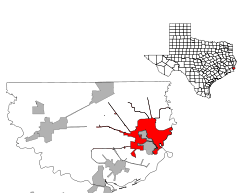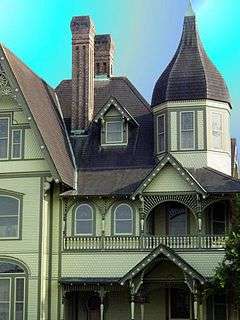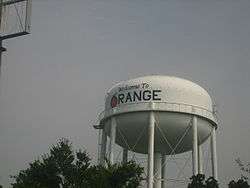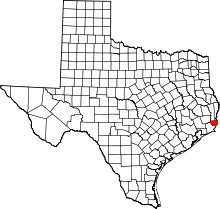Orange, Texas
| Orange, Texas | |
|---|---|
| City | |
|
Water tower in Orange, Texas | |
| Motto: Small town charm, world class culture. | |
|
Location of Orange, Texas | |
 | |
| Coordinates: 30°6′33″N 93°45′33″W / 30.10917°N 93.75917°WCoordinates: 30°6′33″N 93°45′33″W / 30.10917°N 93.75917°W | |
| Country |
|
| State |
|
| County | Orange |
| Community | 1830 as Green's Bluff[1] |
| Renamed | 1840 as Madison[1] |
| County Seat | 1852[1] |
| Incorporated | 1858 as Orange[1] |
| Gentilic | Orangite |
| Government | |
| • Type | Council-Manager |
| • City Council |
Mayor Jimmy Sims Patrick A. Pullen Dr. Wayne Guidry Essie Bellfield Annette Pernell Bill Mello Larry Spears Jr. |
| • City Manager | Shawn Oubre |
| Area | |
| • Total | 20.8 sq mi (53.8 km2) |
| • Land | 20.1 sq mi (52.0 km2) |
| • Water | 0.7 sq mi (1.8 km2) |
| Elevation | 7 ft (2 m) |
| Population (2010) | |
| • Total | 18,595 |
| • Density | 872.7/sq mi (336.9/km2) |
| Time zone | Central (CST) (UTC-6) |
| • Summer (DST) | CDT (UTC-5) |
| ZIP codes | 77630-77632 |
| Area code(s) | 409 |
| FIPS code | 48-54132[2] |
| GNIS feature ID | 1375304[3] |
| Website | OrangeTexas.net |
Orange is a town in Orange County, Texas, United States. As of the 2010 census, the city population was 18,595. It is the county seat of Orange County,[4] and is the easternmost city in Texas. Located on the Sabine River at the border with Louisiana, Orange is 113 miles from Houston and is part of the Beaumont−Port Arthur Metropolitan Statistical Area. Founded in 1836, it is a deep-water port to the Gulf of Mexico.
History
This community was originally called Green Bluff for a man named Reason Green, a Sabine River boatman who arrived at this location sometime before 1830. A short time later, in 1840, the town was renamed Madison in honor of President James Madison.[5] To resolve the frequent post office confusion with another Texas community called Madisonville, the town was renamed "Orange" in 1858. The area experienced rapid growth in the late 19th century due to 17 sawmills within the city limits, making Orange the center of the Texas lumber industry.[6] Orange's growth led to the arrival of many immigrants in the late 19th century, including a moderately-sized Jewish population by 1896.[7] In 1898, the County built a courthouse in the city, which eventually burned down and was replaced by the Orange County Courthouse.
The harbor leading into the Port of Orange was dredged in 1914 to accommodate large ships. Ship building during World War I contributed to the growth in population and economy. The Great Depression, not surprisingly, affected the city negatively, and it was not until World War II that the local economy was boosted again. A U.S. Naval Station was installed and additional housing was provided for thousands of defense workers and servicemen and their families. The population increased to just over 60,000 residents.
After the war, the peace-time population decreased to about 25,000. At this time, the Navy Department announced it selected Orange as one of eight locations where it would store reserve vessels. The area of the shipyards provided a favorable location, as the Sabine River furnished an abundant supply of fresh water to prevent saltwater corrosion.[8]
Also during this period the local chemical plants expanded which boosted the economy. The chemical industry continues today as a leading source of revenue to the area. The U.S. Naval Station was changed to a Reserve base in December 1975, and decommissioned completely in September, 2008.
The Port of Orange became the home to the USS Orleck (DD-886), one of the few naval ships remaining that was built at the Orange shipyards during WWII. The city of Orange sustained a direct hit from Hurricane Rita in 2005, causing damage to the ship. The city decreed that the ship be moved because, as it claimed, the city needed the dock space. The Orleck was not allowed to return to the port due to politics (as the city council was wanting the ship cut up and sold for scrap and had a long running feud with the Restoration Association) so a new location was sought, including one in Arkansas and Lake Charles, Louisiana, for a new home. On May 6, 2009, the Lake Charles city council voted in favor of an ordinance authorizing the city to enter into a "Cooperative Endeavor Agreement" with the "USS ORLECK". On May 20, 2010 the ship was moved to Lake Charles. The Grand Opening was on April 10, 2011.[9]
Hurricane Ike
Orange was heavily damaged by Hurricane Ike on September 13, 2008.[10] Damage was widespread and severe across Orange County. The 22-foot (6.7 m) storm surge breached the city's levees, caused catastrophic flooding and obliterated everything in its path. The storm surge traveled up the Neches River to also flood Rose City.
Orange received winds at hurricane force. Nearly the entire city of 19,000 people was flooded, anywhere from 6 inches (15 cm) to 15 feet (4.5 m).[11] The mayor of the city said about 375 people, of those who stayed behind during the storm, began to emerge, some needing food, water and medical care.[11] Many dead fish littered streets and properties.[12] Neighbor Bridge City Mayor Kirk Roccaforte estimated that only 14 homes in the city were unaffected by the surge, five of which were in the Oakview addition on Louise Street in Bridge City. The piles of debris and waterlogged furniture placed outside homes by residents beginning to clean up led the mayor to say "The whole city looks like a flea market."[13] During the post-storm cleanup, Bridge City residents found swimming pools had been occupied by jellyfish brought inland with the water.[14] Three people were found dead in Orange County on September 29.[15]
Media
Newspaper
The Orange Leader, http://orangeleader.com/
Radio
KOGT 1600 AM
Geography
Orange is located at 30°6′33″N 93°45′33″W / 30.10917°N 93.75917°W (30.109217, -93.759133).[16]
According to the United States Census Bureau, the city has a total area of 20.8 square miles (54 km2), of which, 20.1 square miles (52 km2) of it is land and 0.7 square miles (1.8 km2) of it (3.32%) is water.
Climate
Orange has a humid subtropical climate. Winters are warm and rainy while summers are hot, humid and wet. The climate is similar to nearby Vinton, Louisiana and Beaumont, Texas. The record high in Orange is 105 °F recorded August 10, 1962. The record low is 11 °F recorded December 26, 1983. Orange records about 60 inches of rain per year.
| Climate data for Orange, Texas | |||||||||||||
|---|---|---|---|---|---|---|---|---|---|---|---|---|---|
| Month | Jan | Feb | Mar | Apr | May | Jun | Jul | Aug | Sep | Oct | Nov | Dec | Year |
| Record high °F (°C) | 80 (27) |
82 (28) |
87 (31) |
91 (33) |
95 (35) |
98 (37) |
104 (40) |
105 (41) |
99 (37) |
93 (34) |
87 (31) |
82 (28) |
105 (41) |
| Average high °F (°C) | 60 (16) |
64 (18) |
71 (22) |
77 (25) |
84 (29) |
89 (32) |
91 (33) |
92 (33) |
87 (31) |
80 (27) |
70 (21) |
63 (17) |
77 (25) |
| Average low °F (°C) | 40 (4) |
43 (6) |
50 (10) |
56 (13) |
64 (18) |
70 (21) |
72 (22) |
72 (22) |
67 (19) |
57 (14) |
48 (9) |
42 (6) |
57 (14) |
| Record low °F (°C) | 15 (−9) |
21 (−6) |
24 (−4) |
34 (1) |
47 (8) |
52 (11) |
57 (14) |
58 (14) |
42 (6) |
35 (2) |
23 (−5) |
11 (−12) |
11 (−12) |
| Average precipitation inches (mm) | 6.01 (152.7) |
3.74 (95) |
3.90 (99.1) |
3.61 (91.7) |
5.70 (144.8) |
6.21 (157.7) |
5.34 (135.6) |
4.65 (118.1) |
5.60 (142.2) |
4.56 (115.8) |
4.62 (117.3) |
5.22 (132.6) |
59.16 (1,502.6) |
| Source: [17] | |||||||||||||
Demographics
2010 Census data
As of the census[2] of 2010, there were 18,595 people, 7,585 households, and 5,021 families residing in the city. The population density was 872.7 people per square mile (336.9/km²). There were 8,868 housing units at an average density of 441.7 per square mile (170.5/km²). The racial makeup of the city was 60.9% White, 33.2% African American, 0.3% Native American, 1.7% Asian, NA% Pacific Islander, 1.08% from other races, and 2.0% from two or more races. Hispanic or Latino of any race were 5.2% of the population. The average household size was 2.41.
| Historical population | |||
|---|---|---|---|
| Census | Pop. | %± | |
| 1860 | 936 | — | |
| 1890 | 3,173 | — | |
| 1900 | 3,835 | 20.9% | |
| 1910 | 5,527 | 44.1% | |
| 1920 | 9,212 | 66.7% | |
| 1930 | 7,913 | −14.1% | |
| 1940 | 7,472 | −5.6% | |
| 1950 | 21,174 | 183.4% | |
| 1960 | 25,605 | 20.9% | |
| 1970 | 24,457 | −4.5% | |
| 1980 | 23,628 | −3.4% | |
| 1990 | 19,381 | −18.0% | |
| 2000 | 18,643 | −3.8% | |
| 2010 | 18,595 | −0.3% | |
| Est. 2015 | 19,347 | [18] | 4.0% |
In Orange, the population is 24.8% under the age of 18, and 15.9% who are 65 years of age or older. The median age is 36 years. 51.2% of the population is female. The median income for a household in the city was $41,494. Males had a median income of $55,702 versus $36,295 for females. The per capita income for the city was $24,449. 20.3% of the population were below the poverty line, compared to 15.1% of the national population.
Government and infrastructure
The Texas Department of Criminal Justice (TDCJ) operates the Orange District Parole Office in Orange.[20]
The United States Postal Service operates the Orange Post Office in Orange.[21]
The city operates under the council-manager form of government.
Education
The City of Orange is served by the Little Cypress-Mauriceville Consolidated Independent School District, the West Orange-Cove Consolidated Independent School District, and the Orangefield Independent School District.
Lamar State College-Orange is a community college and part of the Texas State University System.
Culture
The City of Orange hosts several cultural attractions. The Stark Museum of Art, houses one of the finest collections of 19th and 20th century Western American art and artifacts in the country. The collection focuses on the stunning land, dramatic people, and diverse wildlife of the American West. The Museum also holds a significant collection of American Indian art as well as collections of glass and porcelain, and rare books and manuscripts. The museum features the work of artists such as artist/naturalist John James Audubon, Paul Kane, Albert Bierstadt, Thomas Moran, and John Mix Stanley.[22]

The W. H. Stark House is a careful restoration of an 1894 Victorian home, typical of a wealthy Southeast Texas family. The 15-room, three-storied structure with its many gables, galleries, and distinctive windowed turret, shows the influence of several architectural styles.
The First Presbyterian Church on Green Avenue is a strong example of the classic Greek Revival architecture. Completed in 1912, it was the first air-conditioned public building west of the Mississippi River and its dome is the only opalescent glass dome inside of the United States.
Orange Community Players is a non-profit community theater located across the street from the historic courthouse.
The Confederate Memorial of the Wind is being built on private land at the intersection of Interstate 10 and Martin Luther King Jr Drive.[23]
Transportation
Orange is served by Interstate 10, as well as a deep-water seaport. Commercial aviation service is located at nearby Southeast Texas Regional Airport, and general aviation service is provided by Orange County Airport.
Orange has the distinction of having Exit 880 on Interstate 10 within its city limits, which is the highest numbered exit and mile marker on an interstate highway or freeway in North America.
Notable people
- Bonnie Baker
- Marcia Ball
- Garland Bayliss
- Michael Berry
- Clarence "Gatemouth" Brown
- Matt Bryant
- John Oliver Creighton
- Shane Dronett
- Clyde D. Eddleman
- Frances Fisher
- Donovan Gans
- Greg Hill
- Charles Holcomb
- Bobby Kimball
- Danny Klam
- Chuck Knipp
- Ernie Ladd
- Janette Sebring Lowrey
- Jason Mathews
- Danielle Panabaker
- Kay Panabaker
- John Patterson
- Bum Phillips
- Wade Phillips
- Andre Robertson
- R.C. Slocum
- Bubba Smith
- Kevin Smith
- Tody Smith
- William Henry Stark
- Lee Stringer
- Jean A. Stuntz
- Earl Thomas
- Liz Wickersham
References
- 1 2 3 4 "ORANGE, TX | The Handbook of Texas Online| Texas State Historical Association (TSHA)". Tshaonline.org. Retrieved 2016-08-12.
- 1 2 "American FactFinder". United States Census Bureau. Retrieved 2008-01-31.
- ↑ "US Board on Geographic Names". United States Geological Survey. 2007-10-25. Retrieved 2008-01-31.
- ↑ "Find a County". National Association of Counties. Archived from the original on May 10, 2015. Retrieved 2011-06-07.
- ↑ TSHA Online - Texas State Historical Association
- ↑ "Orange Texas, Historic Orange Texas, Orange Texas Hotels.". Retrieved 12 August 2016.
- ↑ "Orange, Texas", found in the Encyclopedia of Southern Jewish Communities,
- ↑ TSHA Online - Texas State Historical Association
- ↑ Williams, Ronald. "Welcome to the USS Orleck Naval Museum". Retrieved 12 August 2016.
- ↑ "USATODAY.com". Retrieved 12 August 2016.
- 1 2 Oren Dorell (2008-09-15). "Almost 2,000 Ike survivors rescued". USA TODAY. Retrieved 2008-09-15.
- ↑ "Ike: A fish story." CNN.
- ↑ "Bridge City residents try to dry out, clean up". Retrieved 12 August 2016.
- ↑ "Archived copy". Archived from the original on September 26, 2008. Retrieved September 26, 2008.
- ↑ "More Victims Raise Ike's Death Toll To 67". WCVB. Associated Press. 2008-09-30. Retrieved 2008-09-30.
- ↑ "US Gazetteer files: 2010, 2000, and 1990". United States Census Bureau. 2011-02-12. Retrieved 2011-04-23.
- ↑ "Monthly Averages for Orange, TX". Retrieved 2012-03-16.
- ↑ "Annual Estimates of the Resident Population for Incorporated Places: April 1, 2010 to July 1, 2015". Retrieved July 2, 2016.
- ↑ "Census of Population and Housing". Census.gov. Archived from the original on May 11, 2015. Retrieved June 4, 2015.
- ↑ "Parole Division Region I." Texas Department of Criminal Justice. Retrieved on May 15, 2010.
- ↑ "Post Office Location - ORANGE." United States Postal Service. Retrieved on May 15, 2010.
- ↑ "Stark Cultural Venues". Retrieved 12 August 2016.
- ↑ Savage, John (August 10, 2016). "Where the Confederacy Is Rising Again". Politico. Retrieved August 12, 2016.
External links
| Wikimedia Commons has media related to Orange, Texas. |


